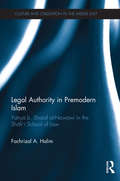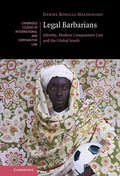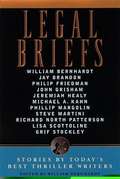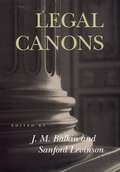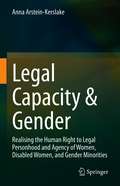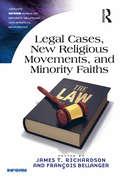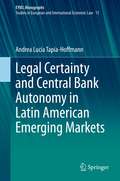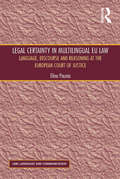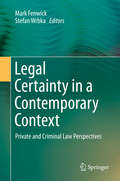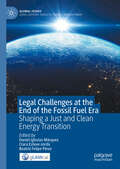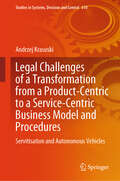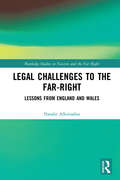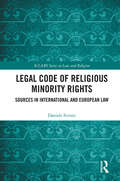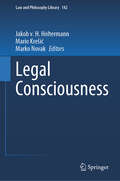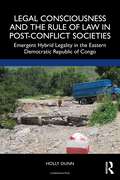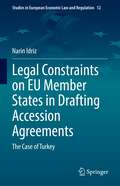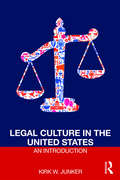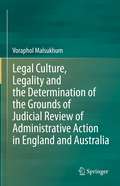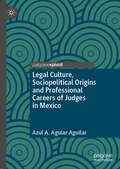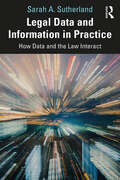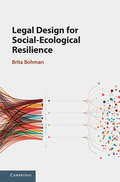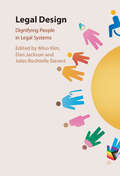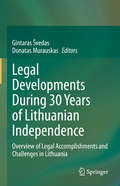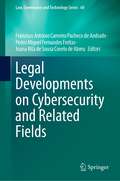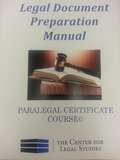- Table View
- List View
Legal Authority in Premodern Islam: Yahya B Sharaf Al-Nawawi in the Shafi'i School of Law (Culture and Civilization in the Middle East)
by Fachrizal A. HalimOffering a detailed analysis of the structure of authority in Islamic law, this book focuses on the figure of Yahyā b. Sharaf al-Nawawī, who is regarded as the chief contributor to the legal tradition known as the Shāfi'ī madhhab in traditional Muslim sources, named after Muhammad b. Idrīs al-Shāfi'ī (d. 204/820), the supposed founder of the school of law. Al-Nawawī’s legal authority is situated in a context where Muslims demanded to stabilize legal disposition that is consistent with the authority of the madhhab, since in premodern Islamic society, the ruling powers did not produce or promulgate law, as was the case in other, monarchic civilizations. Al-Nawawī’s place in the long-term formation of the madhhab is significant for many reasons but for one in particular: his effort in reconciling the two major interpretive communities among the Shāfi'ites, i.e., the tarīqas of the Iraqians and Khurasanians. This book revisits the history of the Shāfi'ī school in the pre-Nawawic era and explores its later development in the post-Nawawic period. Presenting a comprehensive picture of the structure of authority in Islamic law, specifically within the Shafi’ite legal tradition, this book is an essential resource for students and scholars of Islamic Studies, History and Law.
Legal Barbarians: Identity, Modern Comparative Law and the Global South (Cambridge Studies in International and Comparative Law #157)
by Daniel Bonilla MaldonadoIn this novel and unorthodox historical analysis of modern comparative law, Daniel Bonilla Maldonado explores the connections between modern comparative law and the identity of the modern legal subject. Narratives created by modern comparative law shed light on the role played by law in the construction of modern individual and collective identities. This study first examines the relationship between identity, law, and narrative. Second, it explores the moments of emergence and transformation of this area of law: instrumental comparative studies, comparative legislative studies, and comparative law as an autonomous discipline. Finally, it analyzes the theoretical perspectives that question the narrative created by modern comparative law: Third World Approaches to International Law, postcolonial studies of law, and critical comparative law. For lawyers and legal scholars, this study brings a nuanced understanding of the connections between the theory of modern comparative law and contemporary practical legal and political issues.
Legal Briefs: Stories By Today's Best Legal Thriller Writers
by William BernhardtFrom an all-star team of legal thriller writers, eleven stories of top-flight suspense. William Bernhardt, author of seven bestselling novels featuring attorney Ben Kincaid, asked ten of his fellow lawyer/authors to contribute their most fiendishly clever short pieces for this anthology, and told them their imaginations were their only guides. The result is Legal Briefs, a smorgasbord of stories boasting a wonderful variety of themes and styles. From John Grisham's exploration of a doctor's guilt in "The Birthday" to Richard North Patterson's story of a lawyer's loyalty to his mentor in "The Client," to Grif Stockley's tale of a divorce lawyer who learns the hard way that things are not always what they seem, these pieces showcase the extraordinary depth and breadth of talent among the new breed of legal thriller writers. Some of these stories feature twisting and inventive plots; some illuminate the moral dilemmas and psychological complexities faced by the modern-day lawyer; some are good, old-fashioned yarns. But for all their diversity of approaches and characters, these writers understand that the courtrooms and law firms from which they came offer the raw material for the most dramatic, suspenseful stories you can read. Legal Briefs will be a delight for fans of all these bestselling authors, and a splendid introduction to their talents for all readers new to the genre.
Legal Canons
by J. M. Balkin & Sanford LevinsonEvery discipline has its canon: the set of standard texts, approaches, examples, and stories by which it is recognized and which its members repeatedly invoke and employ. Although the last twenty-five years have seen the influence of interdisciplinary approaches to legal studies expand, there has been little recent consideration of what is and what ought to be canonical in the study of law today. Legal Canons brings together fifteen essays which seek to map out the legal canon and the way in which law is taught today. In order to understand how the twin ideas of canons and canonicity operate in law, each essay focuses on a particular aspect, from contracts and constitutional law to questions of race and gender. The ascendance of law and economics, feminism, critical race theory, and gay legal studies, as well as the increasing influence of both rational-actor methodology and postmodernism, are all scrutinized by the leading scholars in the field. A timely and comprehensive volume, Legal Canons articulates the need for, and means to, opening the debate on canonicity in legal studies. Table of Contents
Legal Capacity & Gender: Realising the Human Right to Legal Personhood and Agency of Women, Disabled Women, and Gender Minorities
by Anna Arstein-KerslakeThis book is one of the first to explore legal capacity denial in relation to women, disabled women, and gender minorities. It discusses in depth the meaning of the right to legal capacity and its two core elements – legal personhood and legal agency. Using critical feminist, disability, and queer theory, it offers insights into the construction of legal personhood and its role as a predictor of power and privilege. The book also identifies patterns of oppression through legal capacity denial in various jurisdictions and discusses cases in which modern law continues to enforce these denials. Legal capacity is essential for an individual’s participation in society. It is required for voting, marrying, inheriting, contracting, consenting and other areas that are critical components of social structures and can be predictors of power and privilege. Historically, women have been denied legal capacity in many ways. For example, they have been denied legal capacity to vote, inherit, and contract – and some of these practices continue today. The legal capacity of disabled women is frequently denied through laws that deny decision-making on the basis of disability, such as guardianship, mental health laws and capacity to consent laws. In turn, the legal capacity of gender minorities is also denied in numerous ways – for example, in situations where government-issued identification, such as a passport, is required for the exercise of legal capacity but requires gender-binary identification. In these situations, it may be impossible or very dangerous for some gender minorities to acquire or use such identification – resulting in an inability to exercise their legal capacity. In these ways and many others, the intersection of disability and gender can result in multiple forms of marginalisation through legal capacity denial.The right to legal capacity has been protected in international human rights law since the 1960s. It is derived from the right to equal recognition before the law, which can be found in the 1966 International Covenant on Civil and Political Rights (ICCPR). It was reiterated in more detail in the 1979 Convention on the Elimination of Discrimination Against Women (CEDAW) and finally enumerated extensively in the 2006 Convention on the Rights of Persons with Disabilities (CRPD). Article 12 of the CRPD explicitly guarantees the right to legal capacity and establishes a state obligation to provide support for the exercise of legal capacity. This book argues that the right to legal capacity is a non-derogable civil and political right. It presents both a legal argument to support this, as well as a normative analysis of the importance of the right to legal capacity in maintaining equality in socio-legal systems. In addition, the book presents solutions: it identifies practices to learn from in various jurisdictions around the world – including both civil law and common law jurisdictions. It also uses case studies to illustrate the ways in which existing laws, policies and practices could be reformed. As such, the book offers both a novel contribution to the field of legal capacity law and a tool for creating change and helping to realise the right to legal capacity for all.
Legal Cases, New Religious Movements, and Minority Faiths (Routledge Inform Series on Minority Religions and Spiritual Movements)
by James T. Richardson François BellangerNew religious movements (NRMs) and other minority faiths have regularly been the focus of legal cases around the world in recent decades. This is the first book to focus on important aspects of the relationship of smaller faiths to the societies in which they function by using specific legal cases to examine social control efforts. The legal cases involve group leaders, a groups’ practices or alleged abuses against members and children in the group, legal actions brought by former members or third parties, attacks against such groups by outsiders including even governments, and libel and slander actions brought by religious groups as they seek to defend themselves. These cases are sometimes milestones in the relation between state authorities and religious groups. Exploring cases in different parts of the world, and assessing the events causing such cases and their consequences, this book offers a practical insight for understanding the relations of NRMs and other minority religions and the law from the perspective of legal cases. Chapters focus on legal, political, and social implications. Including contributions from scholars, legal practitioners, actual or former members, and authorities involved in such cases from various jurisdictions, this book presents an objective approach to understanding why so many legal actions have involved NRMs and other minority faiths in recent years in western societies, and the consequences of those actions for the society and the religious group as well.
Legal Certainty and Central Bank Autonomy in Latin American Emerging Markets (European Yearbook of International Economic Law #15)
by Andrea Lucia Tapia-HoffmannThis book provides a comparative analysis of the legal frameworks of six Latin American central banks to determine whether there is legal certainty regarding central bank autonomy. Based on this, it ascertains whether the way in which legal institutions are designed – specifically those that rule the autonomy of the central bank – provides reasons to believe that central banks can keep inflation at bay even if governments face fiscal problems or pursue contradictory objectives. The analysis covers three key areas: a constitutional analysis, a detailed study of the central bank statutes and a study of a number of underexplored threats to central bank autonomy. After defining and identifying different types of legal certainty and linking them to the credibility of government promises, the author goes on to examine the grounds that the law provides for confidence that central banks operate independently of political influence. The second part of the book focuses on a granular analysis of the legal design of the central banks’ objectives and autonomy. Lastly, the third part features two case studies that represent little-known and unusual institutional threats to legal certainty relating to central bank autonomy, such as the interventions by the Constitutional Court of Colombia in the autonomy of the Colombian central bank, and the interventions of the Argentinean executive and legislative branches in the autonomy of Argentina’s central bank through stabilization plans introduced via emergency laws and decrees.In sum, the book suggests that there are serious doubts about the ability of Latin American central banks to maintain price stability over time. Although central banks were granted a degree of autonomy, authorities in Latin American countries are able to affect central bank decisions. Most importantly, a lack of clarity, inconsistencies, or generous exceptions in the law provide ways for authorities to influence central banks even without bending or disregarding the rules.
Legal Certainty in Multilingual EU Law: Language, Discourse and Reasoning at the European Court of Justice (Law, Language and Communication)
by Elina PaunioHow can multilingualism and legal certainty be reconciled in EU law? Despite the importance of multilingualism for the European project, it has attracted only limited attention from legal scholars. This book provides a valuable contribution to this otherwise neglected area. Whilst firmly situated within the field of EU law, the book also employs theories developed in linguistics and translation studies. More particularly, it explores the uncertainty surrounding the meaning of multilingual EU law and the impact of multilingualism on judicial reasoning at the European Court of Justice. To reconceptualize legal certainty in EU law, the book highlights the importance of transparent judicial reasoning and dialogue between courts and suggests a discursive model for adjudication at the European Court of Justice. Based on both theory and case law analysis, this interdisciplinary study is an important contribution to the field of European legal reasoning and to the study of multilingualism within EU legal scholarship.
Legal Certainty in a Contemporary Context
by Stefan Wrbka Mark FenwickThisbook addresses issues concerning the shifting contemporary meaning of legalcertainty. The book focuses on exploring the emerging tensions that existbetween the demand for legal certainty and the challenges of regulatingcomplex, late modern societies. The book is divided into two parts: the firstpart focusing on debates around legal certainty at the national level, with aprimary emphasis on criminal law; and the second part focusing on debates atthe transnational level, with a primary emphasis on the regulation oftransnational commercial transactions. Inthe context of legal modernity, the principle of legal certainty--the idea thatthe law must be sufficiently clear to provide those subject to legal norms withthe means to regulate their own conduct and to protect against the arbitraryuse of public power--has operated as a foundational rule of law value. Eventhough it has not always been fully realized, legal certainty has functioned asa core value and aspiration that has structured normative debates throughoutpolitical modernity, both at a national and international level. Inrecent decades, however, legal certainty has come under increasing pressurefrom a number of competing demands that are made of contemporary law, inparticular the demand that the law be more flexible and responsive to a socialenvironment characterized by rapid social and technological change. Theexpectation that the law operates in new transnational contexts and regulatesevery widening sphere of social life has created a new degree of uncertainty,and this change raises difficult questions regarding both the possibility anddesirability of legal certainty. This book compiles, in one edited volume, research from a range ofsubstantive areas of civil and criminal law that shares a common interest inunderstanding the multi-layered challenges of defining legal certainty in alate modern society. The book will be of interest both to lawyers interested inunderstanding the transformation of core rule of law values in the context ofcontemporary social change and to political scientists and social theorists.
Legal Challenges at the End of the Fossil Fuel Era: Shaping a Just and Clean Energy Transition (Global Issues)
by Daniel Iglesias Márquez Clara Esteve-Jordà Beatriz Felipe PérezThis edited collection proposes a wide range of approaches to address the legal issues pertaining to the end of the fossil fuel era. While the fossil fuel era is coming to an end both because of the inherent limits of its resources and because of the need to prevent to further pump out CO2 in an already saturated atmosphere, the legal dispositions to ensure an ordered and rational shift toward cleaner energy still need to be developed. Not only in relation to CO2 emissions themselves but also in relation to the manifold issues related to environmental justice in an era of global climate change and global warming. This book is unique in that it provides a theoretical framework but also works to address cutting edge issues through a series of case studies.
Legal Challenges of a Transformation from a Product-Centric to a Service-Centric Business Model and Procedures: Servitisation and Autonomous Vehicles (Studies in Systems, Decision and Control #610)
by Andrzej KrasuskiThis book provides a comprehensive examination of the key legal issues related to the implementation of digital servitisation in mobility business models, focusing particularly on autonomous vehicles. The investigation explores three primary areas of concern.Firstly, it analyses the role of autonomous vehicles within digital servitisation mobility business models, addressing the legal classification of these vehicles and the implications of swarm intelligence. This book informs the evaluation of legal relationships between entities that create value through digital mobility services and the underlying technologies, particularly in relation to autonomous vehicles.Secondly, it considers the legal status and rights of customers in various capacities, including drivers, passengers, and consumers of transportation services provided by autonomous vehicles offering digital service options. Distinguishing these aspects is crucial, as customers are the ultimate beneficiaries of the product-service systems linked to the deployment of autonomous vehicles. Given the complex and multi-stakeholder landscape surrounding these vehicles, customers are exposed to potential risks, especially concerning privacy protection, cybersecurity, and the effective enforcement of consumer rights.The third area highlights the resources required to implement digital business models, including digital platforms. Digital platforms are integral to the ecosystem of entities that create and deliver digital mobility services. Their market position necessitates the establishment of appropriate legal regulations to mitigate their influence.This book is aimed at academic researchers and students, as well as legal professionals associated with vehicle manufacturers and their partners engaged in providing digital mobility services. This demographic encompasses car-sharing companies, digital platform providers, and technology suppliers that facilitate these services, including software for vehicle connectivity and positioning technologies.
Legal Challenges to the Far-Right: Lessons from England and Wales (Routledge Studies in Fascism and the Far Right)
by Natalie AlkiviadouThe work considers the international and European obligations of the UK in the realm of challenging the far-right and assesses the extent to which it adheres to them. It looks at the role of criminal law in tackling hate speech and hate crime and assesses how English law deals with political parties which may deviate from agreed norms and principles such as non-discrimination. The legal analysis is placed within a contextual framework of far-right parties in the United Kingdom and also incorporates a definitional framework in terms of how the law defines themes relevant to challenging the far-right, such as racial discrimination, terrorism and extremism. The book presents a valuable guide for students, academics and policy-makers in the areas of International Human Rights Law, Criminal Law, Comparative Constitutional Law, National Security Law, Comparative Politics and Terrorism Studies.
Legal Code of Religious Minority Rights: Sources in International and European Law (ICLARS Series on Law and Religion)
by Daniele FerrariThis volume presents a systematic collection of the various international legal sources that define the rights of religious minorities.In a time of increasing tensions around religious minorities, this volume presents a systematic collection of international and European documents on the protection and promotion of religious minorities’ rights. The code includes documents from the United Nations, the Council of Europe, the Organization for Security and Cooperation in Europe and the European Union. An index system connects the various sources and norms, and emphasizes the strengths and the weaknesses in the legal frameworks of international and European institutions. While allowing for further research on the historical and conceptual development in the area, the code provides the reader with a new, easily accessible tool facilitating experts and actors who wish to improve the knowledge and protection of religious minorities. This book will be an invaluable resource for students, academics and researchers interested in law and religion, international law, public law and human rights law, the code is also a powerful tool for minorities themselves, and for advocates of their rights.
Legal Consciousness (Law and Philosophy Library #142)
by Marko Novak Mario Krešić Jakob V. H. HoltermannThis book is based on presentations and discussions at the special workshop &“The concept of Legal Consciousness&” held on July 7, 2022, in Bucharest, Romania, as part of thirtieth biennial World Congress of the International Association for the Philosophy of Law and Social Philosophy (IVR). The workshop was focused on the importance of this concept for legal theory, legal sociology, and legal psychology (&“psychology and law&”). The book consists of fourteen contributions divided into four thematic parts elaborating the following topics: concept of law, methodology of legal sciences, role of legal consciousness in legal theory and legal sociology, adjudication, constitutionalization, modification of the legal system, and the deliberate normative change.
Legal Consciousness and the Rule of Law in Post-Conflict Societies: Emergent Hybrid Legality in the Eastern Democratic Republic of Congo
by Holly DunnThis book considers how legal reforms and awareness raising associated with building the rule of law have engaged the popular legal consciousness, producing contradictions that have in turn shaped the nature of the resultant legality. How are popular legal-justice beliefs and practices transformed when legal reforms encounter local contexts and cultures? For over a decade, scholars have engaged with the argument that legal reform through rule of law building is the answer to the various ills of countries transitioning from war to peace or authoritarianism to democracy. Yet, scholars have also repeatedly critiqued rule of law building projects: The rule of law, in theory and in practice, is a product of Western liberal thought and development and provides limited space for local culture, norms, and practices. This tension has been playing out in multiple locations, and in the Democratic Republic of Congo for about two decades. This book examines how rule of law reforms in the Democratic Republic of Congo shape local understandings and practices of law and justice. Instead of focusing on their so-called successes and failures, it explores popular legal consciousness – how people think about, perceive, and engage with the law – to draw broader conclusions about the practical, everyday outcomes of attempts to build the rule of law. This book will appeal to comparativists, Africanists, and socio-legal scholars who study post-conflict reconstruction, rule of law building, legal consciousness, access to justice and legal pluralism, as well as those with practical interests in these areas.
Legal Constraints on EU Member States in Drafting Accession Agreements: The Case of Turkey (Studies in European Economic Law and Regulation #12)
by Narin IdrizDo Member States of the EU have a free hand in drafting Accession Treaties, or are there legal constraints on their primary law-making powers in this regard? That is the main question this book addresses. It argues that such constraints do exist, and seeks to identify them, thereby providing a number of insights into the nature of the EU’s legal order. The point of departure as well as the main focus of the study is the proposed permanent safeguard clause (PSC) on the free movement of persons in the Negotiating Framework for Turkey. Legal provisions, rules, principles and norms that might constrain Member States in this regard are identified with reference to the PSC. The book examines constraints on Member States stemming from three sources of EU law: Association Law, based on the existing legal framework built on the EEC-Turkey Association Agreement (Part I); EU Enlargement Law, comprised of past practice and existing EU rules on enlargement (Part II); and the foundations of EU Constitutional Law (Part III), which constrain Member States whenever they act within the scope of Union law both as primary and secondary lawmakers. Part III reveals what the Court of Justice of the EU considers to be the essence or the ‘very foundations’ of the Union’s legal order, which it protects against encroachment. This is similar to what some constitutional courts do to protect the ‘inner unity’ or ‘basic structure’ of their constitutions. The findings of this book can be applied to the accession of any candidate state. It also sheds light on important implications for future treaty amendments, and for identifying possible limits to differentiated integration.
Legal Culture in the United States: An Introduction (Zones of Religion)
by Kirk JunkerFor law students and lawyers to successfully understand and practice law in the U.S., recognition of the wider context and culture which informs the law is essential. Simply learning the legal rules and procedures in isolation is not enough without an appreciation of the culture that produced them. This book provides the reader with an understandable introduction to the ways in which U.S. law reflects its culture and each chapter begins with questions to guide the reader, and concludes with questions for review, challenge and further understanding. Kirk W. Junker explores cultural differences, employing history, social theory, philosophy, and language as "reference frames," which are then applied to the rules and procedures of the U.S. legal system in the book’s final chapter. Through these cultural reference frames readers are provided with a set of interpretive tools to inform their understanding of the substance and institutions of the law. With a deeper understanding of this cultural context, international students will be empowered to more quickly adapt to their studies; more comprehensively understand the role of the attorney in the U.S. system; draw comparisons with their own domestic legal systems, and ultimately become more successful in their legal careers both in the U.S. and abroad.
Legal Culture, Legality and the Determination of the Grounds of Judicial Review of Administrative Action in England and Australia
by Voraphol MalsukhumThis book presents a navigating framework of legal culture and legality to facilitate a comprehensive understanding of the English and Australian determination of the grounds of judicial review. This book facilitates tangible process of how and why jurisdictional error, jurisdictional fact, proportionality and substantive legitimate expectations are debatable in English law, while they are either completely rejected or firmly entrenched in Australian law. This book argues that these differences are not just random. Legality is not just a fig-leaf, but is profoundly rooted in legal systems’ legal culture; hence, it dictates the way in which courts empower, justify, constrain or limit the scope of judicial review. This book presents evidence that courts differ in legal systems and apply diverse ways to determine the scope of judicial review based on their deep understanding of legality, which is embedded in the legal culture of their legal system. This book uses comparative methodology and develops this framework between English and Australian law. Although obvious and important, this book presents a kind of examination that has never been undertaken in this depth and detail before.
Legal Culture, Sociopolitical Origins and Professional Careers of Judges in Mexico
by Azul A. Aguiar AguilarThis book explores the careers, professional trajectories and legal cultures of judges in the federal judiciary in Mexico. So far, there has been limited research on internal factors contributing to the understanding of judicial power dynamics in Mexico and other Latin American countries at large; this Work fills an important gap in the literature through its empirical investigation of internal legal cultures and judicial norms, offering new data, measurement strategies,and insights into the interactions between law, politics, norms, legal culture(s), as well as judicial behavior. Utilising an original survey, the chapters analyse judicial conceptualizations of role norms, legal cultures, proclivities for judicial activism, and judicial behavior. In so doing, this book contributes to understanding of underlying key internal factors of judicial activism or restraint, in turn moving forward the debate that seeks to explain judicial behavior reliant on internal and ideational perspectives. Complementing limited but existing studies of judicial politics in Mexico through its analysis of judges beyond those that sit at the Supreme Court, this book will be of particular interest to Latin-American judicial politics scholars due to its focus on the judicial power from internal perspectives as well as sub-national judges, filling a void in the literature vis-à-vis the study of courts in Latin America. This Work was originally written in Spanish, and the translation was done with the help of artificial intelligence. A subsequent human revision was done primarily in terms of content.
Legal Data and Information in Practice: How Data and the Law Interact
by Sarah A. SutherlandLegal Data and Information in Practice provides readers with an understanding of how to facilitate the acquisition, management, and use of legal data in organizations such as libraries, courts, governments, universities, and start-ups. Presenting a synthesis of information about legal data that will furnish readers with a thorough understanding of the topic, the book also explains why it is becoming crucial that data analysis be integrated into decision-making in the legal space. Legal organizations are looking at how to develop data-driven insights for a variety of purposes and it is, as Sutherland shows, vital that they have the necessary skills to facilitate this work. This book will assist in this endeavour by providing an international perspective on the issues affecting access to legal data and clearly describing methods of obtaining and evaluating it. Sutherland also incorporates advice about how to critically approach data analysis. Legal Data and Information in Practice will be essential reading for those in the law library community who are based in English-speaking countries with a common law tradition. The book will also be useful to those with a general interest in legal data, including students, academics engaged in the study of information science and law.
Legal Design for Social-Ecological Resilience
by Brita BohmanTheories of social-ecological resilience have developed over the past decades and rapidly become an important framework for governance of complex non-linear environmental problems. This book explores the resilience theories and their compatibility with law, it identifies corresponding legal features. The legal features identified, including legal measures, mechanisms, principles and approaches, form a legal design for social-ecological resilience. A legal design that can be applied to different governance situations. It can be a tool both for designing new laws, as well as for assessing the effectiveness of current laws and legal systems. In many ways environmental law has adjusted and developed new approaches to meet complex environmental problems, but law is still challenged by the complexity that characterize environmental problems and the environmental change connected with the Anthropocene. This book provides a comprehensive review of the most fundamental components of the governance framework for social-ecological resilience and the role of law.
Legal Design: Dignifying People in Legal Systems
by Dan Jackson Miso Kim Jules Rochielle SievertLegal design is a rapidly growing field that seeks to improve the legal system's accessibility, usability, and effectiveness through human-centered design methods and principles. This book provides a comprehensive introduction to legal design, covering fundamental concepts, definitions, and theories. Chapters explore the role of legal design in promoting dignity, equity, and justice in the legal system. Contributors present a range of community-driven projects and method-focused case studies that demonstrate the potential of legal design to transform how people experience the law. This book is an essential resource for anyone interested in the future of law and the intersection of design and justice.
Legal Developments During 30 Years of Lithuanian Independence: Overview of Legal Accomplishments and Challenges in Lithuania
by Gintaras Švedas Donatas MurauskasThis volume provides an overview of selected major areas of legal and institutional development in Lithuania since the Restoration of Independence in 1990. The respective chapters discuss changes in fields varying from the constitutional framework to criminal law and procedure. The content highlights four major aspects of the fundamental changes that have affected the entire legal system: the Post-Soviet country’s complex historical heritage; socio-political and other conditions in the process of adopting new (rule of law) standards; international legal influences on the national legal order over the past 30 years; and finally, the search for entirely new national legal models.Over a period of 30 years since gaining its independence from the Soviet Union, Lithuania has undergone unique social changes. The state restarted its independent journey burdened by the complicated heritage of the Soviet legal system. Some major reforms have taken place swiftly, while others have required years of thorough analysis of societal needs and the search for optimal examples in other states. The legal system is now substantially different, with some elements being entirely new, and others adapted to present needs.
Legal Developments on Cybersecurity and Related Fields (Law, Governance and Technology Series #60)
by Francisco António Carneiro Pacheco de Andrade Pedro Miguel Fernandes Freitas Joana Rita de Sousa Covelo de AbreuThis book presents a fresh approach to cybersecurity issues, seeking not only to analyze the legal landscape of the European Union and its Member States, but to do so in an interdisciplinary manner, involving scholars from diverse backgrounds – ranging from legal experts to ICT and engineering professionals.Cybersecurity requirements must be understood in a broader context, encompassing not just conventional aspects, but also emerging topics. This can only be achieved through an interdisciplinary approach. Indeed, cybersecurity should be consistently considered in relation to cybercrime and/or cyber defense, while examining it through the lens of specific domains that are intertwined with various legal fields. Moreover, it is crucial to uphold ethical standards and safeguard fundamental rights, particularly regarding personal data protection.By adopting this comprehensive perspective, the significance of cybersecurity in the exercise of public authority becomes apparent. It also plays an essential role in upholding the fundamental values of both individual Member States and the EU as a whole, such as the rule of law. Moreover, it fosters trust, transparency, and effectiveness in market relations and public administration interactions.In turn, the book draws on the expertise of its authors to provide insights into ICT components and technologies. Understanding these elements holistically is essential to viewing every "cyber" phenomenon from a legal standpoint. In addition to the holistic and interdisciplinary approach it presents, the book offers a captivating exploration of cybersecurity and an engaging read for anyone interested in the field.
Legal Document Preparation Manual: FOR PARALEGAL CERTIFICATE COURSE©
by Scott A. HatchThis book is designed to be used in conjunction with the Paralegal Certificate Course' and other paralegal studies courses to quickly and efficiently prepare paralegals. The notes and samples are designed to reinforce course lesson materials, and to help the student learn to apply the concepts and practical skills necessary for a successful paralegal career. Please note that any examples provided are for instructional purposes only and may not reflect proper formatting guidelines for all jurisdictions. As always, check your local rules of court for exact document specifications and filing requirements.
